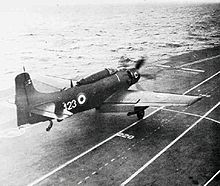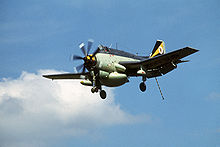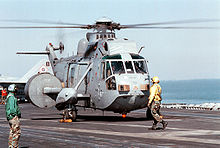- 849 Naval Air Squadron
-
849 Naval Air Squadron 
Primus video (The first to see)Active 1943-1945, 1952-1978, 1984- Country UK Branch Royal Navy, Fleet Air Arm Type Carrier based squadron Role Airborne Early Warning Garrison/HQ RNAS Culdrose Anniversaries none Engagements Normandy 1944, Palembang 1945, Okinawa 1945, Japan 1945, Iraq 2003 Commanders Notable
commandersL/C(A) K G Sharp RN Lt Cdr Charles Gidley Wheeler (Senior Pilot, 1969-1970)
849 Naval Air Squadron is a squadron of the Fleet Air Arm, the Air Arm of the British Royal Navy. It was formed during the Second World War as a carrier based torpedo-bomber, unit, flying missions against Japanese targets in the Far East. Its service since the Second World War has been as an airborne early warning squadron, flying fixed winged Skyraiders and Gannets from the Royal Navy's fixed wing carriers from 1952 until 1978, and airborne early warning Sea King helicopters since 1982.
Contents
Operational history
World War two
849 Naval Air Squadron was formed on 1 August 1943 at the Naval Air Station Quonset Point, Rhode Island with Grumman Avenger Is. It returned to the UK and provided anti-surface vessel and anti-submarine patrols over the English Channel prior to and during the D-Day operations.[1]
In August 1944, it was sent to Ceylon to join the British Eastern Fleet, embarking on HMS Victorious (and becoming part of the British Pacific Fleet in November 1944). It took part in Operation Lentil against oil installations at Pangkalan Brandan in Sumatra on 4 January 1945, and in the larger carrier strikes against the oil refineries at Palembang Sumatra (Operation Meridian on 24 and 29 January.[2]
Victorious, including 849 in its Carrier Air Group, took part in operations in support of the American invasion of Okinawa from March to May 1945, flying strikes against airfields used by Japanese Kamikaze aircraft on the Sakishima Islands and on Formosa. Still aboard Victorious, No. 849 took place in raids against the Japanese Home islands in July and August, including the bombing raids on 24 July that resulted in severe damage to the Japanese escort carrier Kaiyo. It disbanded on 31 October 1945.[3]
Airborne Early Warning (1953-78)
It reformed at Brawdy on 7 July 1953 with the Skyraider AEW.1 as an Airborne Early Warning unit, from 778 Naval Air Squadron.[4][5] Following the retirement of the Skyraiders around 1960, the unit flew a number of variants of the Fairey Gannet in the same role, disbanding again on 15 December 1978.
In November 1970 Bristol Belle, one of the first hot air balloons to fly in UK, was piloted by Lt Terry Adams, accompanied by Lt Howard Draper both of 849 Squadron B Flight (Gannets). This early morning launch carried mail into Malta whilst the Ark Royal was steaming off the southern coast of that island.
Helicopter AEW (1984 to date)
It reformed after the lessons of the 1982 South Atlantic campaign had been learned, on 8 November 1984 and the unit now operates the Westland Sea King Mk7 Airborne Surveillance and Control (ASaC) helicopter. The squadron has its headquarters at RNAS Culdrose in Cornwall and operates 9 aircraft. It is divided into three elements - two flights (A and B), or Aardvarks and Bees and the Operational Conversion Unit (OCU)(Previously known as HQ). Historically a Flight is assigned to each of the two active aircraft carriers in the Royal Navy but this system is currently changing. The squadron suffered heavy losses during the 2003 invasion of Iraq when two of its aircraft operating from HMS Ark Royal collided during low visibility conditions. Six squadron members and an American exchange officer were killed in the collision.
On 13 December 2006, after a short ceremony at RNAS Culdrose, A Flight became 854 Squadron and B Flight became 857 Squadron, taking the former's Sea King ASaC.7 with them.
Notes
References
- "Naval Early Warners:No. 849 A Unique Fleet Air Arm Squadron". Flight, 22 October 1954, pp. 604–605.
- Brown, David. Carrier Air Groups: HMS Eagle: Volume 1. Windsor, UK:Hylton Lacy,1972. ISBN 0-85464-103-9.
Currently active squadrons Inactive squadrons 701 • 704 • 706 • 707 • 708 • 709 • 710 • 711 • 712 • 713 • 714 • 715 • 716 • 717 • 718 • 719 • 720 • 721 • 722 • 723 • 724 • 725 • 726 • 728 • 728B • 729 • 730 • 731 • 732 • 733 • 734 • 735 • 736 • 737 • 738 • 739 • 740 • 741 • 742 • 743 • 744 • 745 • 746 • 747 • 748 • 749 • 751 • 752 • 753 • 754 • 755 • 756 • 757 • 758 • 759 • 760 • 761 • 762 • 763 • 764 • 765 • 766 • 767 • 768 • 769 • 770 • 772 • 773 • 774 • 775 • 776 • 777 • 778 • 779 • 780 • 781 • 782 • 783 • 784 • 785 • 786 • 787 • 788 • 789 • 790 • 791 • 793 • 794 • 795 • 796 • 797 • 798 • 799 • 800 • 801 • 802 • 803 • 804 • 805 • 806 • 807 • 808 • 809 • 810 • 811 • 812 • 813 • 816 • 817 • 818 • 819 • 821 • 822 • 823 • 825 • 826 • 827 • 828 • 830 • 831 • 832 • 833 • 834 • 835 • 836 • 837 • 838 • 840 • 841 • 842 • 850 • 851 • 852 • 853 • 855 • 856 • 860 • 861 • 870 • 871 • 877 • 878 • 879 • 880 • 881 • 882 • 883 • 884 • 885 • 886 • 887 • 888 • 889 • 890 • 891 • 892 • 893 • 894 • 895 • 896 • 897 • 898 • 899 • 1700 · 1701 • 1702 • 1703 • 1770 • 1771 • 1772 • 1790 • 1791 • 1792 • 1820 • 1830 • 1831 • 1832 • 1833 • 1834 • 1835 • 1836 • 1837 • 1838 • 1839 • 1840 • 1841 • 1842 • 1843 • 1844 • 1845 • 1846 • 1847 • 1848 • 1849 • 1850 • 1851 • 1852 • 1853
Display teams Fred's Five • Simon's Sircus • Blue Herons • Sharks • Black Cats
Other units HMS Gannet SAR Flight • Fleet Requirements and Aircraft Direction Unit • Royal Navy Historic Flight
Categories:- 800 series Fleet Air Arm squadrons
- Military units and formations established in 1943
- Military of the United Kingdom in Cornwall
Wikimedia Foundation. 2010.




